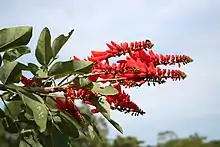| Erythrina senegalensis | |
|---|---|
 | |
| Scientific classification | |
| Kingdom: | Plantae |
| Clade: | Tracheophytes |
| Clade: | Angiosperms |
| Clade: | Eudicots |
| Clade: | Rosids |
| Order: | Fabales |
| Family: | Fabaceae |
| Subfamily: | Faboideae |
| Genus: | Erythrina |
| Species: | E. senegalensis |
| Binomial name | |
| Erythrina senegalensis | |
| Synonyms[2] | |
| |
Erythrina senegalensis, the Senegal coraltree,[3] is a plant in the pea family Fabaceae, native to West Africa.
Description
Erythrina senegalensis grows as a tree up to 7 metres (23 ft) tall, rarely to 15 m (50 ft). The bark is fissured. The leaves are composed of three leaflets which measure up to 15 cm (6 in) long, on a thorny stalk. Inflorescences have many flowers with bright red petals. The seeds are poisonous.[2]
Distribution and habitat
Erythrina senegalensis is native to West Africa, across the region from Mauritania to Chad and Cameroon. Its habitat is in wooded grassland or savanna.[2]
Uses
Erythrina senegalensis is locally used in traditional medicine. The wood is locally used to make knife handles and the seeds to make necklaces. The species is cultivated as an ornamental and also used in hedges.[2]
References
- ↑ Contu, S. (2012). "Erythrina senegalensis". IUCN Red List of Threatened Species. 2012: e.T19892718A20072141. doi:10.2305/IUCN.UK.2012.RLTS.T19892718A20072141.en. Retrieved 20 November 2021.
- 1 2 3 4 5 "Erythrina senegalensis". Plants of the World Online. Royal Botanic Gardens, Kew. Retrieved 18 March 2020.
- ↑ "Erythrina senegalensis". Germplasm Resources Information Network. Agricultural Research Service, United States Department of Agriculture. Retrieved 18 March 2020.
